Note
Access to this page requires authorization. You can try signing in or changing directories.
Access to this page requires authorization. You can try changing directories.
APPLIES TO:  2013
2013  2016
2016  2019
2019  Subscription Edition
Subscription Edition  SharePoint in Microsoft 365
SharePoint in Microsoft 365
Prerequisites
When you configure SharePoint Server with Active Directory Federation Services (AD FS) using OpenID Connect (OIDC) authentication, you need the following resources to perform the configuration:
- A SharePoint Server Subscription Edition farm.
- AD FS in Windows Server 2016 or later, already created, with the public key of the AD FS signing certificate exported in a
.cerfile.
This article uses the following example values for AD FS OIDC setup:
| Value | Link |
|---|---|
| SharePoint site URL | https://spsites.contoso.local/ |
| AD FS site URL | https://adfs.contoso.local/adfs/ |
| AD FS authentication endpoint | https://adfs.contoso.local/adfs/oauth2/authorize |
| RegisteredIssuerName URL | https://adfs.contoso.local/adfs/ |
| AD FS SignoutURL | https://adfs.contoso.local/adfs/oauth2/logout |
| Identity claim type | http://schemas.xmlsoap.org/ws/2005/05/identity/claims/emailaddress |
| Windows site collection administrator | contoso\yvand |
| Email value of the federated (AD FS) site collection administrator | yvand@contoso.local |
Step 1: Setup identity provider
Perform the following steps to set up OIDC with AD FS:
In AD FS Management, right-click on Application Groups and select Add Application Group.
Go to the Welcome page, enter ADFSSSO in the Name field and under Client-Server applications, select the Web browser accessing a web application template. Then, select Next.
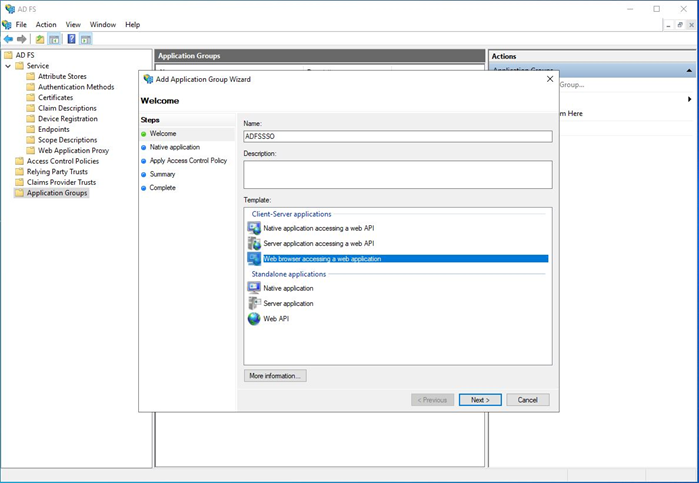
Go to the Native Application page and copy the Client Identifier value. It will be used later as the value for
DefaultClientIdentifierparameter during SharePoint configuration.Under the Redirect URL field, enter
https://spsites.contoso.local/and select Add. Then, select Next.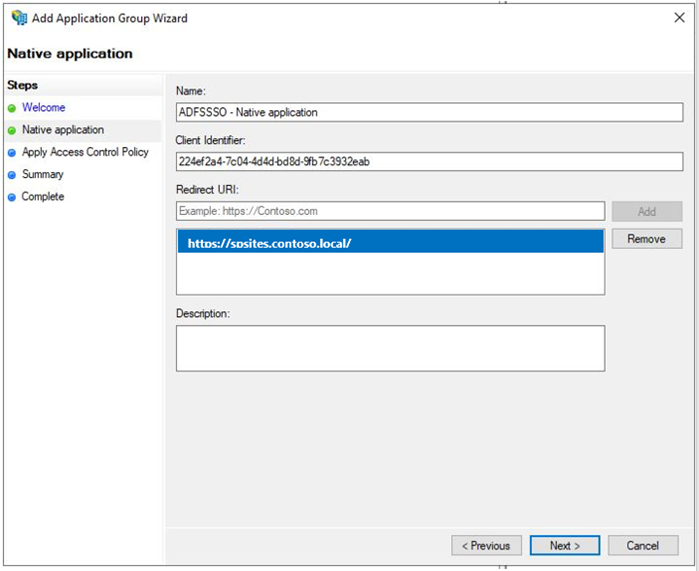
Go to the Summary page and select Next.
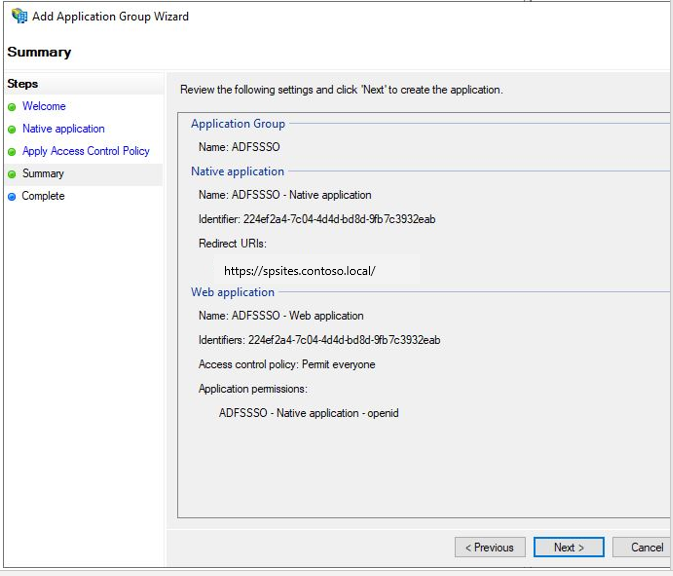
Go to the Complete page and select Close.
Export Token-signing certificate from AD FS. This token-signing certificate will be used in SharePoint setup. The following images show how to export Token-signing certificate from AD FS:
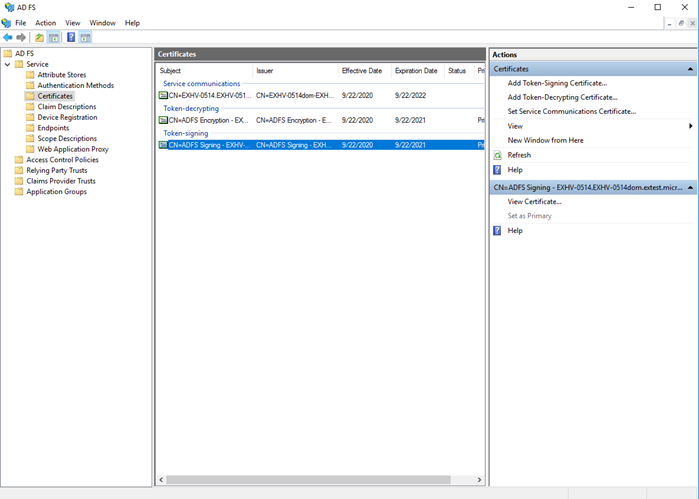
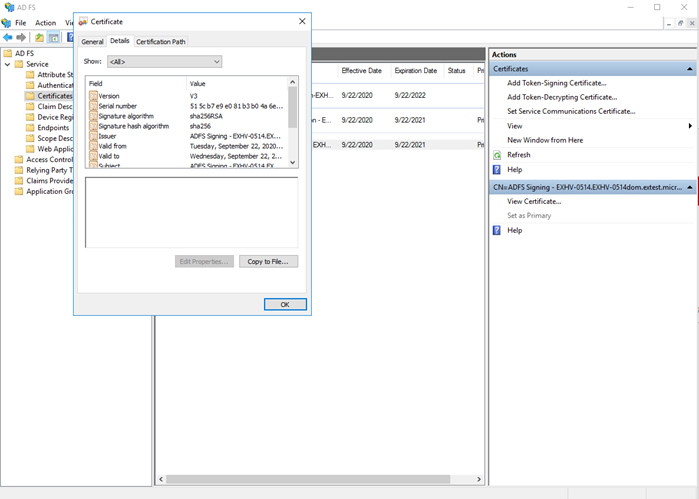
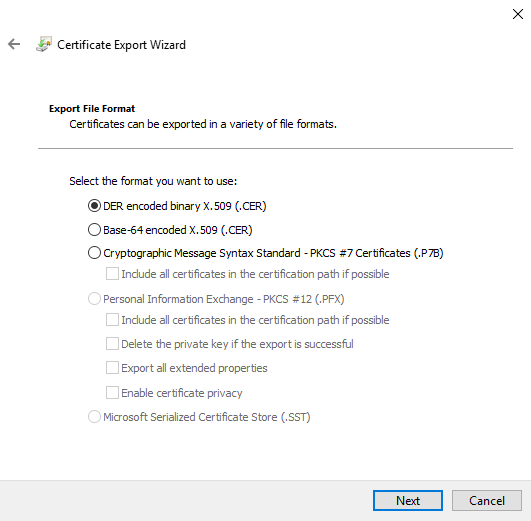
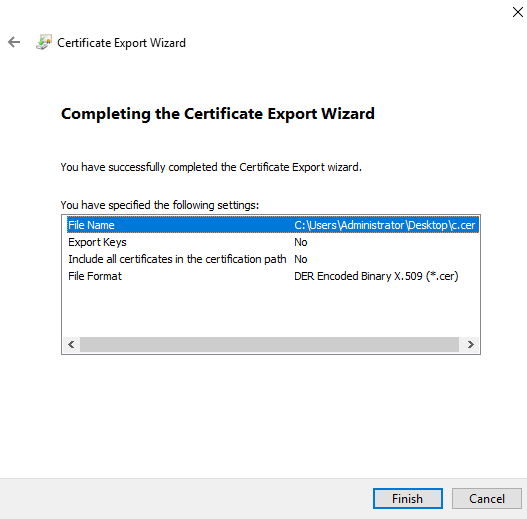
Ensure that the required claim ID is included in the
id_tokenfrom AD FS. Let’s consider email as an example:We assume that your AD FS has configured the rule that read identifier claim from attribute store, such as AD. Perform the following steps to create Issuance Transform Rule for this specific web application we created in AD FS previously:
Open the web application you created and go to the Issue Transformation Rule tab.
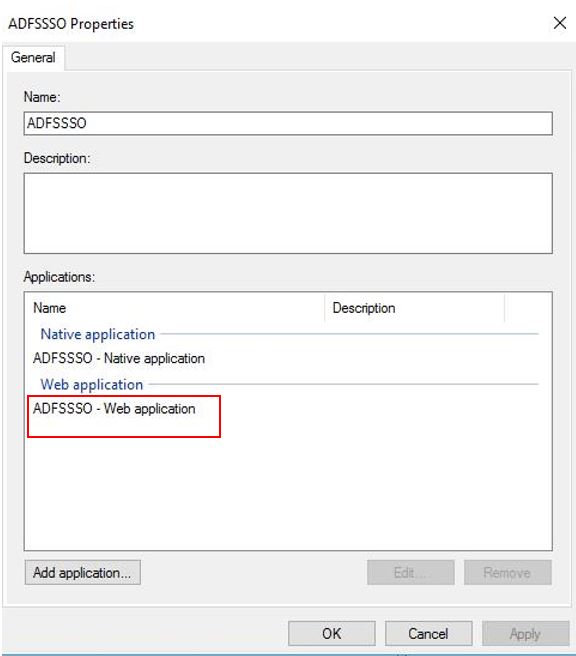
Select Add Rule and select Send LDAP Attributes as Claims from the option list.
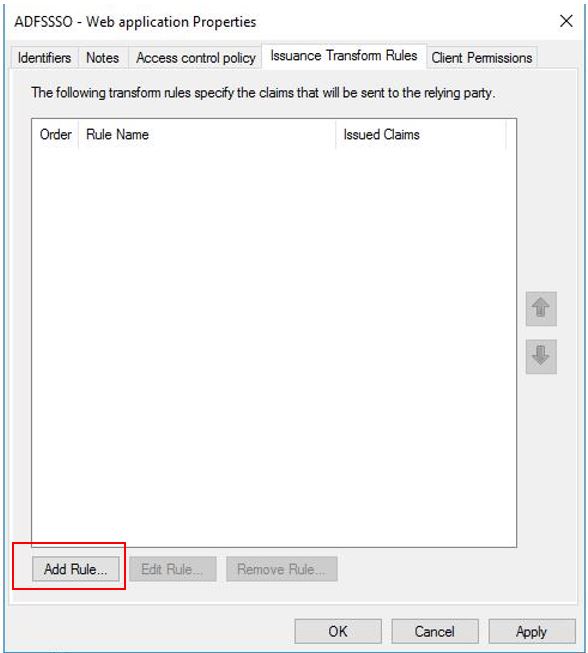
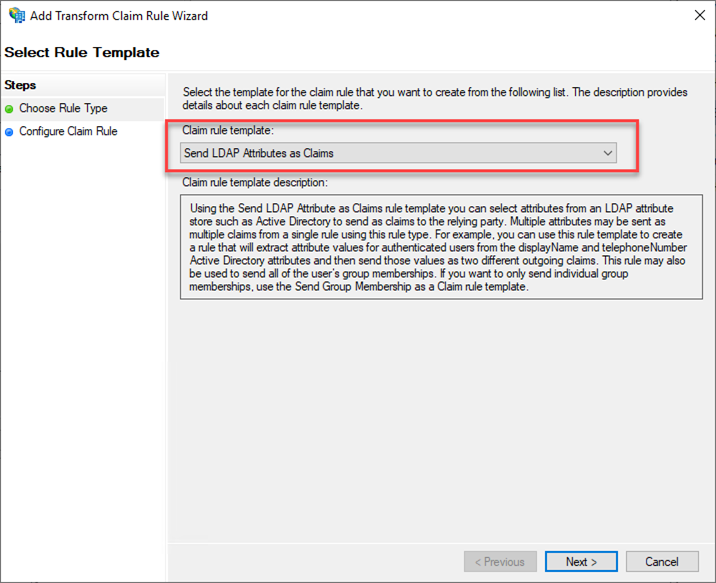
Name your Claim rule as AD and select Active Directory from the Attribute store dropdown menu. Create two mappings using the drop-down boxes as shown:
Attribute Value E-Mail-Addresses E-Mail Address Token-Groups - Qualified by Domain Name Role 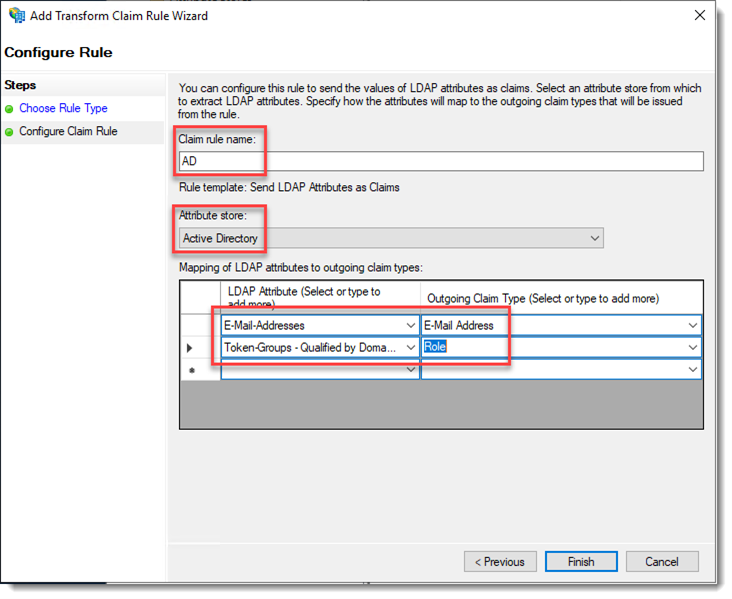
Select Finish to close the Rule wizard and select OK to close the web application properties. Select OK one more time to complete the Rule.
If you're setting OIDC with SharePoint Server, nbf claim must be configured in AD FS server side in the web application you created. If nbf claim doesn’t exist in this web application, perform the following steps to create it:
Open the web application you created and go to the Issue Transformation Rule tab.

Select Add Rule and then select Apply. In the Add Transform Claim Rule Wizard select Send Claims Using a Custom Rule from the Claim rule template options.

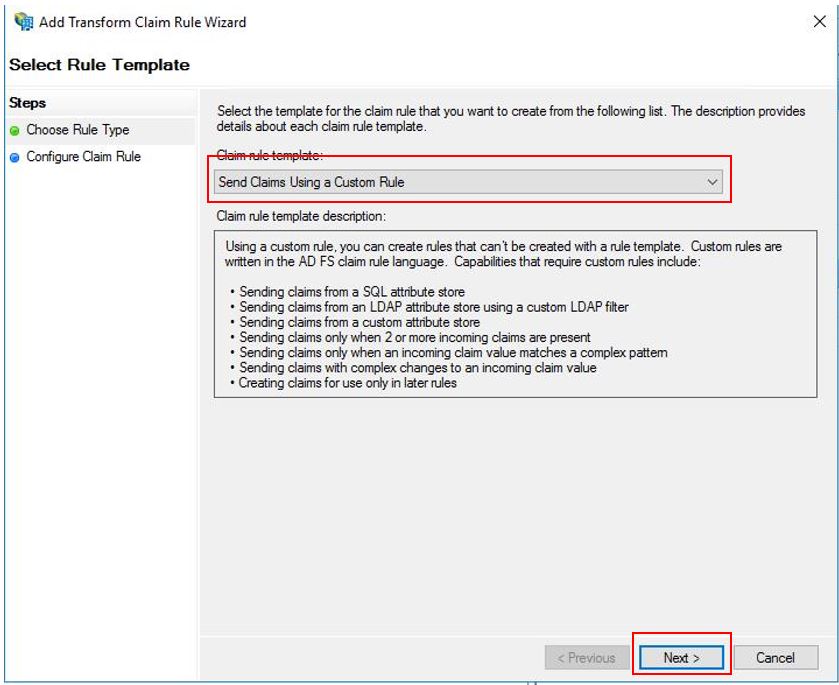
Select Next and input the following string in the Custom rule field:
c:[Type == "http://schemas.microsoft.com/ws/2008/06/identity/claims/windowsaccountname"] => issue(Type = "nbf", Value = "0");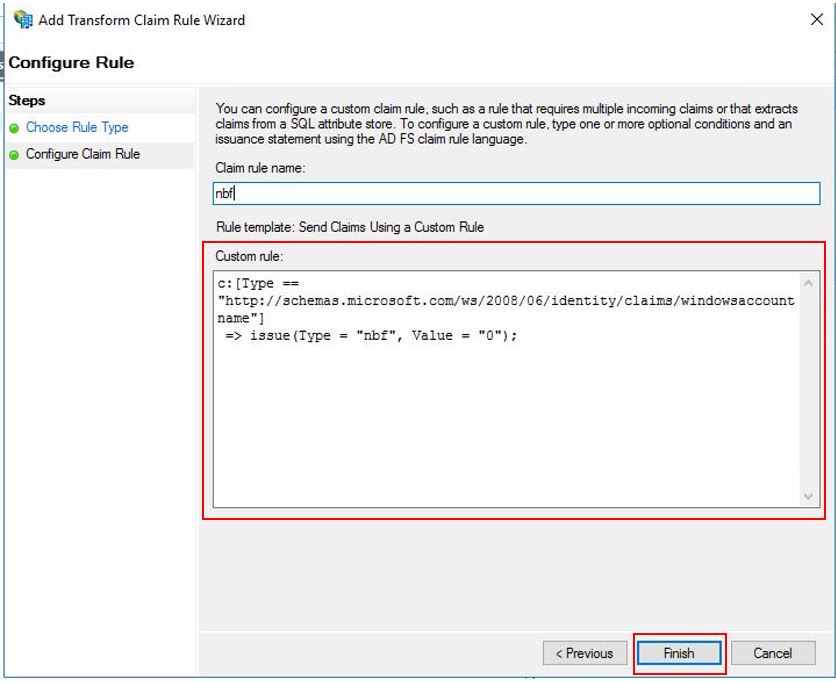
Select Finish.
Step 2: Change SharePoint farm properties
In this step, you need to modify the SharePoint Server farm properties based on the version of your SharePoint Server farm.
- For more information on configuring SharePoint farm properties for SharePoint Server Subscription Edition Version 24H1, see Configure SPSE Version 24H1 or higher version.
- For more information on configuring SharePoint farm properties for SharePoint Server Subscription Edition Version preceding 24H1, see Configure SPSE prior to Version 24H1.
Configure SharePoint Server Subscription Edition Version 24H1 or higher versions with Early Release feature preference
Starting with SharePoint Server Subscription Edition Version 24H1 (March 2024), if the SharePoint farm is configured for Early Release feature preference, you can configure SharePoint Server farm properties by employing SharePoint Certificate Management to manage the nonce cookie certificate. The nonce cookie certificate is part of the infrastructure to ensure OIDC authentication tokens are secure. Run the following PowerShell script to configure:
Important
To use this script, the SharePoint farm must be set to Early Release, as noted above. If it is not, the script will complete without error, but the call to $farm.UpdateNonceCertificate() will not do anything. If you do not want to configure your farm for Early Release, then you must use the Configure SPSE prior to Version 24H1 steps instead.
Note
Start the SharePoint Management Shell as a farm administrator to run the following script. Read the instructions mentioned in the following PowerShell script carefully. You will need to enter your own environment-specific values in certain places.
# Set up farm properties to work with OIDC
# Create the Nonce certificate
$cert = New-SelfSignedCertificate -CertStoreLocation Cert:\LocalMachine\My -Provider 'Microsoft Enhanced RSA and AES Cryptographic Provider' -Subject "CN=SharePoint Cookie Cert"
# Import certificate to Certificate Management
$certPath = "<path and file name to save the exported cert. ex: c:\certs\nonce.pfx>"
$certPassword = ConvertTo-SecureString -String "<password>" -Force -AsPlainText
Export-PfxCertificate -Cert $cert -FilePath $certPath -Password $certPassword
$nonceCert = Import-SPCertificate -Path $certPath -Password $certPassword -Store "EndEntity" -Exportable:$true
# Update farm property
$farm = Get-SPFarm
$farm.UpdateNonceCertificate($nonceCert,$true)
Configure SharePoint Server Subscription Edition prior to Version 24H1
# Set up farm properties to work with OIDC
$cert = New-SelfSignedCertificate -CertStoreLocation Cert:\LocalMachine\My -Provider 'Microsoft Enhanced RSA and AES Cryptographic Provider' -Subject "CN=SharePoint Cookie Cert"
$rsaCert = [System.Security.Cryptography.X509Certificates.RSACertificateExtensions]::GetRSAPrivateKey($cert)
$fileName = $rsaCert.key.UniqueName
# If you have multiple SharePoint servers in the farm, you need to export the certificate by Export-PfxCertificate and import the certificate to all other SharePoint servers in the farm by Import-PfxCertificate.
# After the certificate is successfully imported to SharePoint Server, we will need to grant access permission to the certificate's private key.
$path = "$env:ALLUSERSPROFILE\Microsoft\Crypto\RSA\MachineKeys\$fileName"
$permissions = Get-Acl -Path $path
# Replace the <web application pool account> with the real application pool account of your web application
$access_rule = New-Object System.Security.AccessControl.FileSystemAccessRule(<Web application pool account>, 'Read', 'None', 'None', 'Allow')
$permissions.AddAccessRule($access_rule)
Set-Acl -Path $path -AclObject $permissions
# Update farm properties
$farm = Get-SPFarm
$farm.Properties['SP-NonceCookieCertificateThumbprint']=$cert.Thumbprint
$farm.Properties['SP-NonceCookieHMACSecretKey']='seed'
$farm.Update()
Step 3: Configure SharePoint to trust the identity providers
In this step, you'll create a SPTrustedTokenIssuer that will store the configuration that SharePoint needs to trust AD FS as an OIDC provider. Start the SharePoint Management Shell as a farm administrator and run the following script to create it:
Note
Read the instructions mentioned in the following PowerShell script carefully. You will need to input environment-specific values in several places.
# Define claim types
$email = New-SPClaimTypeMapping "http://schemas.xmlsoap.org/ws/2005/05/identity/claims/emailaddress" -IncomingClaimTypeDisplayName "EmailAddress" -SameAsIncoming
# Public key of the AD FS signing certificate
$signingCert = New-Object System.Security.Cryptography.X509Certificates.X509Certificate2("C:\Data\Claims\ADFS Signing.cer")
# Set the AD FS URL where users are redirected to authenticate
$authendpointurl = "https://adfs.contoso.local/adfs/oauth2/authorize"
$registeredissuernameurl = "https://adfs.contoso.local/adfs"
$signouturl = "https://adfs.contoso.local/adfs/oauth2/logout"
# Replace <Client Identifier> with the value you saved in step #3 of AD FS Setup section
$clientIdentifier = "<Your Client Identifier>"
# Create a new SPTrustedIdentityTokenIssuer in SharePoint
New-SPTrustedIdentityTokenIssuer -Name "Contoso.local" -Description "Contoso.local" -ImportTrustCertificate $signingCert -ClaimsMappings $email -IdentifierClaim $email.InputClaimType -RegisteredIssuerName $registeredissuernameurl -AuthorizationEndPointUri $authendpointurl -SignOutUrl $signouturl -DefaultClientIdentifier $clientIdentifier
The New-SPTrustedIdentityTokenIssuer PowerShell cmdlet is extended to support OIDC by using the following parameters:
| Parameter | Description |
|---|---|
| Name | Gives a name to the new token issuer. |
| Description | Gives a description to the new token issuer. |
| ImportTrustCertificate | Imports a list of X509 Certificates, which will be used to validate id_token from OIDC identifier. If the OIDC IDP uses more than one certificate to digital sign the id_token, import these certificates and SharePoint will then validate id_token by matching the digital signature generated by using these certificates. |
| ClaimsMappings | A SPClaimTypeMapping object, which will be used to identify which claim in the id_token will be regarded as identifier in SharePoint. |
| IdentifierClaim | Specifies the type of identifier. |
| RegisteredIssuerName | Specifies the issuer identifier, which issues the id_token. It will be used to validate the id_token. |
| AuthorizationEndPointUrl | Specifies the authorization endpoint of the OIDC identity provider. |
| SignoutUrl | Specifies the sign-out endpoint of the OIDC identity provider. |
| DefaultClientIdentifier | Specifies the client_id of SharePoint server, which is assigned by OID identity provider. This will be validated against aud claim in id_token. |
| ResponseTypesSupported | Specifies the response type of IDP, which can be accepted by this token issuer. It can accept two strings: id_token and code id_token. If this parameter isn't provided, it will use code id_token as default. |
Important
The relevant certificate must be added to the SharePoint root authority certificate store and there are two possible options to do this:
If the AD FS signing certificate is issued by a certificate authority (best practice for security reasons).
The public key of the issuer's certificate (and all the intermediates) must be added to the store. Start the SharePoint Management Shell and run the following script to add the certificate:
$rootCert = New-Object System.Security.Cryptography.X509Certificates.X509Certificate2("C:\Data\Claims\ADFS Signing issuer.cer") New-SPTrustedRootAuthority -Name "adfs.contoso.local signing root authority" -Certificate $rootCertIf the AD FS signing certificate is a self-signed certificate (not recommended for security reasons).
The public key of the AD FS signing certificate must be added to the store. Start the SharePoint Management Shell and run the following script to add the certificate:
$rootCert = New-Object System.Security.Cryptography.X509Certificates.X509Certificate2("C:\Data\Claims\ADFS Signing.cer") New-SPTrustedRootAuthority -Name "adfs.contoso.local signing certificate" -Certificate $rootCert
Step 4: Configure a SharePoint web application
In this step, you'll configure a web application in SharePoint to use AD FS OIDC authentication, using the SPTrustedIdentityTokenIssuer that was created in the previous step.
Important
- The default zone of the SharePoint web application must have Windows authentication enabled. This is required for the search crawler.
- The SharePoint URL that will use AD FS OIDC federation must be configured with HTTPS.
You can complete this configuration either by:
Creating a new web application and using both Windows and AD FS OIDC authentication in the Default zone. To create a new web application, do the following:
Start the SharePoint Management Shell and run the following script to create a new
SPAuthenticationProvider:# This script creates a trusted authentication provider for OIDC $sptrust = Get-SPTrustedIdentityTokenIssuer "contoso.local" $trustedAp = New-SPAuthenticationProvider -TrustedIdentityTokenIssuer $sptrustFollow Create a web application in SharePoint Server to create a new web application enabling HTTPS/SSL named SharePoint - OIDC on contoso.local.
Open the SharePoint Central Administration site.
Open the web application you created, choose "Authentication Providers" in the Ribbon, click the link for the "Default" zone, and pick contoso.local as Trusted Identity Provider.
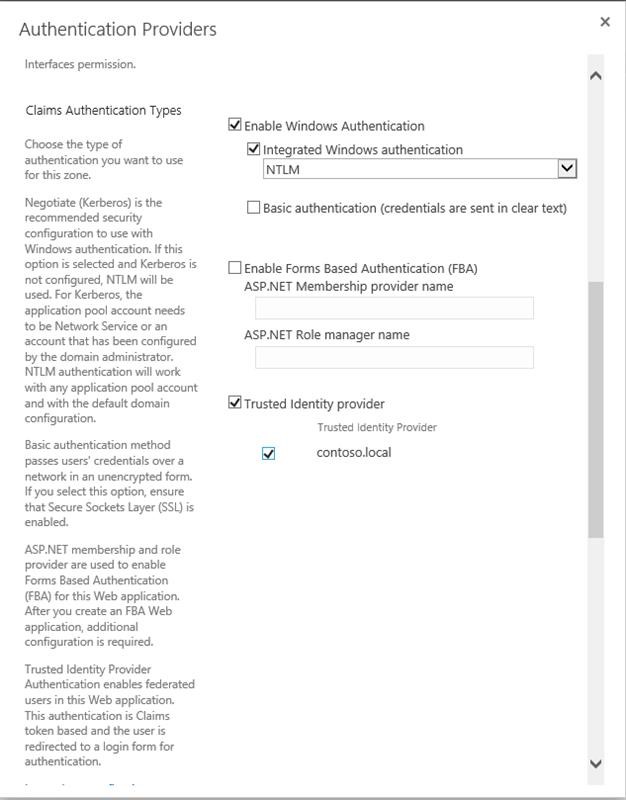
Navigate to System Settings > Configure Alternate Access Mappings > Alternate Access Mapping Collection.
Filter the display with the new web application and confirm that you see the following information:

Extending an existing web application to set AD FS OIDC authentication on a new zone. To extend an existing web application, do the following:
Start the SharePoint Management Shell and run PowerShell to extend the web application:
Example:
# Get the trusted provider $sptrust = Get-SPTrustedIdentityTokenIssuer "Contoso.local" $ap = New-SPAuthenticationProvider -TrustedIdentityTokenIssuer $sptrust # Get the web app $wa = Get-SPWebApplication http://spsites # Extend the web app to the "Intranet" zone using trusted provider auth and a SharePoint managed certificate called "SharePoint OIDC Site" New-SPWebApplicationExtension -Identity $wa -Name "spsites" -port 443 -HostHeader 'spsites.contoso.local'-AuthenticationProvider $ap -SecureSocketsLayer -UseServerNameIndication -Certificate 'SharePoint OIDC Site' -Zone 'Intranet' -URL 'https://spsites.contoso.local'Navigate to System Settings > Configure Alternate Access Mappings > Alternate Access Mapping Collection.
Filter the display with the web application that was extended and confirm that you see the following information:

Step 5: Ensure the web application is configured with SSL certificate
Since OpenID Connect 1.0 authentication can only work with HTTPS protocol, a certificate must be set on the corresponding web application. If you have not already done so, perform the following steps to set a certificate:
Generate the site certificate:
Note
You may skip this step if you have already generated the certificate.
Open the SharePoint PowerShell console.
Run the following script to generate a self-signed certificate and add it to the SharePoint farm:
New-SPCertificate -FriendlyName "Contoso SharePoint (2021)" -KeySize 2048 -CommonName spsites.contoso.local -AlternativeNames extranet.contoso.local, onedrive.contoso.local -OrganizationalUnit "Contoso IT Department" -Organization "Contoso" -Locality "Redmond" -State "Washington" -Country "US" -Exportable -HashAlgorithm SHA256 -Path "\\server\fileshare\Contoso SharePoint 2021 Certificate Signing Request.txt" Move-SPCertificate -Identity "Contoso SharePoint (2021)" -NewStore EndEntityImportant
Self-signed certificates are suitable only for test purposes. In production environments, we strongly recommend that you use certificates issued by a certificate authority instead.
Set the certificate:
You can use the following PowerShell cmdlet to assign the certificate to the web application:
Set-SPWebApplication -Identity https://spsites.contoso.local -Zone Default -SecureSocketsLayer -Certificate "Contoso SharePoint (2021)"
Step 6: Create the site collection
In this step, you create a team site collection with two administrators: One as a Windows administrator and one as a federated (AD FS) administrator.
Open the SharePoint Central Administration site.
Navigate to Application Management > Create site collections.
Type a Title, URL, and select the template Team Site.
In the Primary Site Collection Administrator section, select the book icon to open the People Picker dialog.
In the People Picker dialog, type the Windows administrator account, for example yvand.
Filter the list on the left by selecting Organizations. Following is a sample output:

Go to the account and select OK.
In the Secondary Site Collection Administrator section, select the book icon to open the People Picker dialog.
In the People Picker dialog, type the exact email value of the AD FS administrator account, for example yvand@contoso.local.
Filter the list on the left by selecting Contoso.local. Following is a sample output:
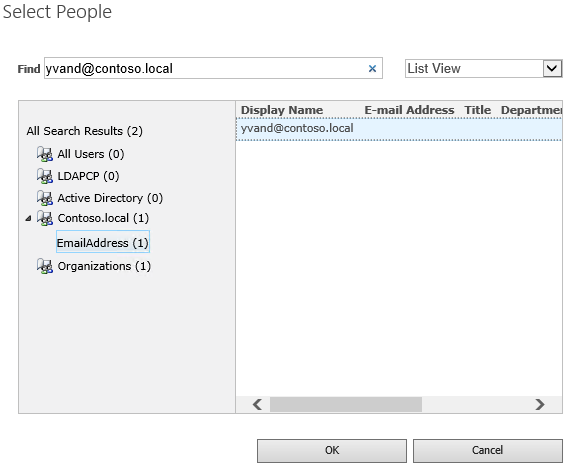
Go to the account and select OK.
Select OK to create the site collection.
Once the site collection is created, you should be able to sign-in using either the Windows or the federated (AD FS OIDC) site collection administrator account.
Step 7: Set up People Picker
In OIDC authentication, the People Picker doesn't validate the input, which can lead to misspellings or users accidentally selecting the wrong claim type. This can be addressed either by using a Custom Claims Provider, or by using the new UPA-backed claim provider included in SharePoint Server Subscription Edition. To configure a UPA-backed claim provider, see Enhanced People Picker for modern authentication.